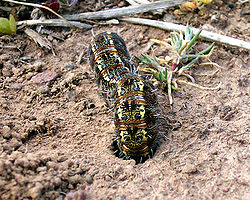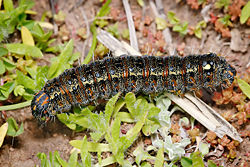
Pasture Day Moth
Encyclopedia
The Pasture Day Moth, Apina callisto (synonym Amazelo callisto), is a species in the Noctuidae
family of moth
s which is, as its name implies, active during the day, making it unlike most other species in the Noctuidae family. It is found in most southern areas of Australia
, ranging from lower Queensland
to Tasmania
.
The Pasture Day Moth lays its eggs in pasture, and they hatch after heavy rains in early spring. When the larvae are fully grown, measuring about 60 mm (2.4 in), they burrow down before becoming pupa
e. They have striking coloration; two yellow stripes run down their mottled-black back, interspersed with blue spots. Their bodies are covered with white spines. They feed on various broad leaved plants (see list below).
The adult moth's wings are black with cream and chestnut markings, with a wingspan of approximately 50 mm (2 in). Its thorax
is black and the abdomen
is orange ringed with black.


Noctuidae
The Noctuidae or owlet moths are a family of robustly-built moths that includes more than 35,000 known species out of possibly 100,000 total, in more than 4,200 genera. They constitute the largest family in the Lepidoptera....
family of moth
Moth
A moth is an insect closely related to the butterfly, both being of the order Lepidoptera. Moths form the majority of this order; there are thought to be 150,000 to 250,000 different species of moth , with thousands of species yet to be described...
s which is, as its name implies, active during the day, making it unlike most other species in the Noctuidae family. It is found in most southern areas of Australia
Australia
Australia , officially the Commonwealth of Australia, is a country in the Southern Hemisphere comprising the mainland of the Australian continent, the island of Tasmania, and numerous smaller islands in the Indian and Pacific Oceans. It is the world's sixth-largest country by total area...
, ranging from lower Queensland
Queensland
Queensland is a state of Australia, occupying the north-eastern section of the mainland continent. It is bordered by the Northern Territory, South Australia and New South Wales to the west, south-west and south respectively. To the east, Queensland is bordered by the Coral Sea and Pacific Ocean...
to Tasmania
Tasmania
Tasmania is an Australian island and state. It is south of the continent, separated by Bass Strait. The state includes the island of Tasmania—the 26th largest island in the world—and the surrounding islands. The state has a population of 507,626 , of whom almost half reside in the greater Hobart...
.
The Pasture Day Moth lays its eggs in pasture, and they hatch after heavy rains in early spring. When the larvae are fully grown, measuring about 60 mm (2.4 in), they burrow down before becoming pupa
Pupa
A pupa is the life stage of some insects undergoing transformation. The pupal stage is found only in holometabolous insects, those that undergo a complete metamorphosis, going through four life stages; embryo, larva, pupa and imago...
e. They have striking coloration; two yellow stripes run down their mottled-black back, interspersed with blue spots. Their bodies are covered with white spines. They feed on various broad leaved plants (see list below).
The adult moth's wings are black with cream and chestnut markings, with a wingspan of approximately 50 mm (2 in). Its thorax
Thorax (insect anatomy)
The thorax is the mid section of the insect body. It holds the head, legs, wings and abdomen. It is also called mesosoma in other arthropods....
is black and the abdomen
Abdomen
In vertebrates such as mammals the abdomen constitutes the part of the body between the thorax and pelvis. The region enclosed by the abdomen is termed the abdominal cavity...
is orange ringed with black.

Recorded food plants

- ArctothecaArctothecaArctotheca is a small genus of flowering plants in the aster family. They are annuals or perennials native to southern Africa. At least two species are widely naturalized elsewhere, including Australia.Species include:...
- Capeweed - ErodiumErodiumErodium is a genus of the botanical family Geraniaceae. The genus includes about 60 species, for the most part originating in the Mediterranean or Western Asian regions...
- Storksbill - LepidiumLepidiumLepidium is a genus of plants in the mustard family Brassicaceae. It includes about 175 species found worldwide, including cress and pepperweed; additional common names include peppercress, peppergrass, and pepperwort...
- MalvaMalvaMalva is a genus of about 25–30 species of herbaceous annual, biennial, and perennial plants in the family Malvaceae , one of several closely related genera in the family to bear the common English name mallow. The genus is widespread throughout the temperate, subtropical and tropical regions of...
- Mallow - Modiola - Bristle Mallow
- PlantagoPlantagoPlantago is a genus of about 200 species of small, inconspicuous plants commonly called plantains. They share this name with the very dissimilar plantain, a kind of banana. Most are herbaceous plants, though a few are subshrubs growing to 60 cm tall. The leaves are sessile, but have a narrow...
- Plantain - PoaceaePoaceaeThe Poaceae is a large and nearly ubiquitous family of flowering plants. Members of this family are commonly called grasses, although the term "grass" is also applied to plants that are not in the Poaceae lineage, including the rushes and sedges...
- Grasses (including PaspalumPaspalumPaspalum is a genus of the grass family . Commonly known as paspalums, bahiagrasses or dallis grasses most are tall perennial American grasses. They are most diverse in subtropical and tropical regions....
) - RumexRumexThe docks and sorrels, genus Rumex L., are a genus of about 200 species of annual, biennial and perennial herbs in the buckwheat family Polygonaceae....
- Salvia - SageSalviaSalvia is the largest genus of plants in the mint family, Lamiaceae, with approximately 700-900 species of shrubs, herbaceous perennials, and annuals. It is one of several genera commonly referred to as sage. When used without modifiers, sage generally refers to Salvia officinalis ; however, it is...
- SonchusSonchusSonchus is a genus of flowering plants in the daisy family Asteraceae. Most of the species are annual herbs, a few are perennial, and some are even woody...
- Sow-thistle - Trifolium - CloverCloverClover , or trefoil, is a genus of about 300 species of plants in the leguminous pea family Fabaceae. The genus has a cosmopolitan distribution; the highest diversity is found in the temperate Northern Hemisphere, but many species also occur in South America and Africa, including at high altitudes...
- RumexRumexThe docks and sorrels, genus Rumex L., are a genus of about 200 species of annual, biennial and perennial herbs in the buckwheat family Polygonaceae....

